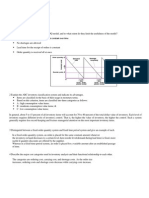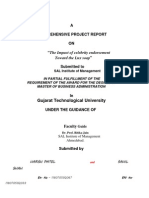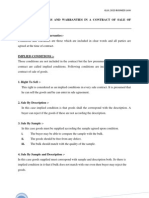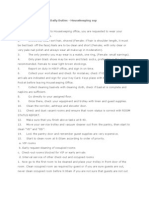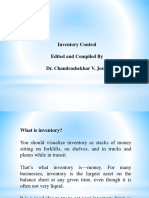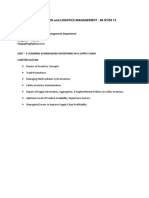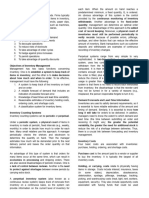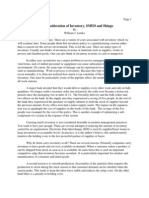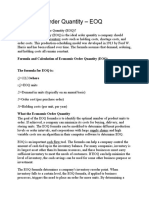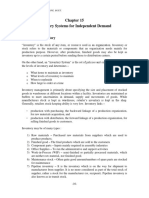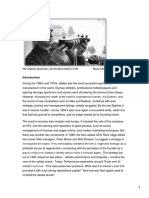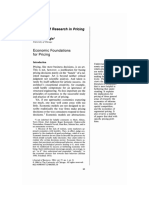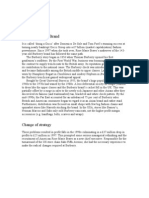Chap 017
Chap 017
Uploaded by
Andrea RobinsonCopyright:
Available Formats
Chap 017
Chap 017
Uploaded by
Andrea RobinsonOriginal Title
Copyright
Available Formats
Share this document
Did you find this document useful?
Is this content inappropriate?
Copyright:
Available Formats
Chap 017
Chap 017
Uploaded by
Andrea RobinsonCopyright:
Available Formats
Chapter 17 - Inventory Control
CHAPTER 17
INVENTORY CONTROL
Review and Discussion Questions
1. Distinguish between dependent and independent demand in a McDonalds, in an integrated
manufacturer of personal copiers, and in a pharmaceutical supply house.
The key to the answer here is to consider what must be forecasted (independent demand), and,
given the forecast, what demands are thereby created for items to meet the forecasts
(dependent demand).
In a McDonalds, independent demand is the demand for various items offered for saleBig
Macs, fries, etc. The demand for Egg McMuffins, for example, needs to be forecasted. Given
the forecast, then, the demand for the number of eggs, cheese, Canadian bacon, muffins, and
containers can then be computed based on the amount needed for each Egg McMuffin.
The manufacturer of copiers is integrated, i.e., the parts, components, etc. are produced
internally. The demand for the number of copiers is independent (must be forecasted). Given
the forecast, the Bill of Materials is exploded to determine the amounts of raw materials,
components, parts, etc. that are needed (more on the BOM in chapter 16).
The pharmaceutical supply company is an extreme case where only end items are carried and
nothing is produced internally. The bill of materials is the end item and, therefore, the
independent demand (forecasted from customers) is the same as the dependent demand. One
might attempt to consider that when the demand for items occurs together, that this is similar
to a bill of materials. However, this is not a bill of materials, but rather a causal relationship
making it easier to forecast.
2. Distinguish between in-process inventory, safety stock inventory, and seasonal inventory.
In-process inventory consists of those items of materials components and partially completed
units that are currently in the production process.
Safety-stock inventory is set so that inventory is maintained to satisfy some maximum level of
demand. It could be stated that safety stock is that level of inventory between the minimum
expected demand and the desired level of demand satisfaction.
Seasonal inventory is that inventory accumulated to meet some periodic increase in demand.
3. Discuss the nature of the costs that affect inventory size.
The optimum inventory size is one that minimizes the combined total of holding cost, ordering
(or setup) cost, shortage cost, and purchase cost.
17-1
Chapter 17 Inventory Control
4.
17-2
Chapter 17 - Inventory Control
Under which conditions would a plant manager elect to use a fixed-order quantity model
as opposed to a fixed-time period model? What are the disadvantages of using a fixedtime period ordering system?
Fixed-order quantity modelswhen holding costs are high (usually expensive items or high
deprecation rates), or when items are ordered from different sources.
Fixed-time period modelswhen holding costs are low (i.e., associated with low-cost items,
low-cost storage), or when several items are ordered from the same source (saves on order
placement and delivery charges).
The main disadvantage of a fixed-time period inventory system is that inventory levels must
be higher to offer the same protection against stockout as a fixed-order quantity system. It
also requires a periodic count and closer surveillance than a fixed-order quantity system. A
fixed-order quantity system can operate with a perpetual count (keeping a running log of every
time a unit is withdrawn or replaced) or through a simple two-bin or flag arrangement wherein
a reorder is placed when the safety stock is reached. This latter method requires very little
attention.
5. What two basic questions must be answered by an inventory-control decision rule?
Any inventory control model or rule must establish (1) when items should be ordered, and (2)
how many should be ordered.
6. Discuss the assumptions that are inherent in production setup cost, ordering cost, and carrying
cost. How valid are they?
Investigation of ordering and production setup cost will likely show that a single, unique cost
does not exist for each product, nor is it linearly related to the number of order (as implied in
the equations or inventory models). In the purchasing department, for example, an employee
is paid either a salary or an hourly rate for a normal work week. The cost for that employee is
sometimes divided among the number of items or orders for which he has responsibility,
resulting in an averaged or allocated cost for each order he places. However, when we
consider an inventory ordering cost based on the number or orders per year (as is done in most
inventory models), reducing the number of orders the individual places does not necessarily
decrease the net cost to the firm since his weekly pay remains the same. What happens is
really an increase in the ordering cost for each of the remaining items within his responsibility.
Nonlinearity of costs also occurs in production setups. Consider the time for making a setup
in preparation for a production run. Setup time is roughly based on an expected frequency of
making this particular product run. However, as the frequency increases, familiarity with the
setup allows some shaving of the setup time. Moreover, if the setup is repeated often, an
investment in specialized equipment or the construction of jigs may become warranted,
reducing the setup time even more.
17-3
Chapter 17 Inventory Control
17-4
Chapter 17 - Inventory Control
The terms carrying or holding costs for maintaining goods in inventory include a multitude of
cost elements. To determine the nature and amounts of these costs can be a challenging feat.
Fortunately, total inventory cost curves tend to be dish shaped and can, therefore, tolerate
some error. The holding costs associated with insurance, obsolescence, and personnel who are
handling materials are extremely difficult to ascertain on an item-by-item basis, yet each
requires realistic analysis. Warehouse storage costs of an item, for example, may be based on
a ratio of its required square footage and the entire available warehouse space, but this may
not be an accurate representation since it is an allocation of cost rather than true cost. Take the
warehouse that is too large, or is used to stock products in an off season or depressed period.
Allocation based on a share of total warehouse cost will result in a high cost for storage, when,
in fact, excess storage space should create pressure for highernot lowerorder quantities.
In the simple inventory model, holding costs are based on the average inventory on hand.
Average inventory presumes that, as stock is depleted, other product lines will be moved in
to occupy the space. It may be that costs should be based on maximum inventory, especially
if these is an excess of space, or if the needs of an item are so specialized that no other
products can use the space (for example, due to environmental requirements). Each remaining
cost may be similarly challenged. Breakage, pilferage, deterioration, and insurance costs are
not constant but, rather, vary with inventory size. As the value of inventory increases,
insurance rates are lower, more refined handling procedures can be installed to reduce
breakage, some environmental control and maintenance can be used to reduce deterioration,
and better security procedures can reduce theft.
These challenges to determining true costs are not intended to discourage the use of inventory
models. The intent, rather, is to prevent the use of any model without clear knowledge of its
requirements and assumptions. Indeed, each application must consider the operating
conditions and needs of the firm. An appropriate model can then be developed in a fashion
similar to those covered in this chapter.
7. The nice thing about inventory models is that you can pull one off the shelf and apply it so
long as your cost estimates are accurate. Comment.
Unfortunately, there is no model or set of models universally applicable to all inventory
situations. As stated in the chapter several times, each situation is different and requires a
model to suit those conditions. Students frequently try to memorize specific models rather
than the process of building any inventory model. See also the answers to question 9 below.
8.
17-5
Chapter 17 Inventory Control
Which type of inventory system would you use in the following situations?
a. Supplying your kitchen with fresh food.
b. Obtaining a daily newspaper.
c. Buying gas for your car.
To which of these items do you impute the highest stockout cost?
(a) Supplying kitchen with foodboth a periodic model and order quantity. Generally, a
household will shop once weekly for the majority of items (periodic), then pick up items
such as bread and milk as the supply runs low (fixed quantity with reorder point).
(b) Obtaining a daily newspapera daily newspaper is obviously a periodic model. One
does not usually wait until he has finished one daily paper before buying the next days
paper.
(c) Buying gas for your cargenerally, this is a hybrid type model wherein a reorder point is
signaled when the gas indicator is low, then the tank is filled. Many people, however,
have a fixed quantity purchase when the reorder point is reached, such as put in 10
gallons or $10.00 worth. Still others (drawing upon our own experience) use a periodic
ordering system on their wifes car, such as taking it out and filling it every Sunday after
church (or in Chases case, after the football game).
The highest stockout cost for most well-fed, well-read individuals would be running out of gas
in your car. The cost could range from practically zero if one runs out in front of a gas station
to being late for an appointment or causing an accident on the highway.
9. Why is it desirable to classify items into groups, as the ABC classification does?
Using a classification scheme such as this one allows a greater portion of time to be spent in
controlling specific groups or classes or items. For the ABC grouping, greater control is
afforded those items which comprise the greatest dollar volume in usage. The result of this
classification is a reduction in the overall inventory size and, therefore, decreased costs for the
same level of satisfying inventory demands.
17-6
Chapter 17 - Inventory Control
Problems
1. Cu = $10 - $4 = $6
Co = $4 - $1.50 = $2.50
Cu
6
.7059
C o C u 2.50 6
, NORMSINV(.7059)=0.541446
Should purchase 250 + .541446 (34) = 268.4 or 268 boxes of lettuce.
2. Cu = $125
Co = $250
Cu
125
.333
C o C u 250 125
, NORMSINV(.333)=-0.43164
Should purchase 25 + (-.43164)(15) = 18.5254.
passengers on the flight.
Super Discount should overbook 19
3.
Qopt
2 DS
2(1000) 25
100
= 22.36 22
4. Service level P = .95, D = 5000, d = 5000/365, T = 14 days, L = 10 days, = 5 per day, and
I =150.
q d (T L) z T L I
T L (T L) 2 (14 10)(5) 2 = 24.495
From Standard normal distribution, z = 1.64
5000
(14 10) 1.64( 24.495) 150
365
= 218.94 219
17-7
Chapter 17 Inventory Control
17-8
Chapter 17 - Inventory Control
5. Service level P = .98, d = 150, T = 4 weeks, L = 3 weeks, = 30 per week, and I =500
pounds.
q d (T L) z T L I
T L (T L) 2 (4 3)(30) 2 = 79.4
From Standard normal distribution, z = 2.05
q 150(4+3) + 2.05(79.4) 500 = 712.77 713pounds
6.
Qopt
a.
2 DS
2(25750)250
.33(10)
= 1975.23 1975
From Standard normal distribution, z = 1.64
R d L z L = 515(1) + (1.64)25 = 556
Q
1975
H
(.33)10
2
b. Holding cost = 2
= $3,258.75
D
25750
S
( 250)
Q
1975
Ordering cost =
= $3,259.49
Q
2000
H
(.33)10
2
c. Holding cost = 2
= $3,300.00
D
25750
S
( 250)
2000
Ordering cost = Q
= $3,218.75
Total annual cost with discount is $6,518.75 50(25750/2000) = $5,875.00, without
discount it is $6,518.24. Therefore, the savings would be $643.24 for the year.
17-9
Chapter 17 Inventory Control
7. Service level P = .98 d = 5 per day, T = 30 days, L = 2 days, = 1 per day, and I =35.
q d (T L) z T L I
T L (T L) 2 (30 2)(1) 2 = 5.657
From Standard normal distribution, z = 2.05
q 5(30 2) 2.05(5.657) 35 = 136.60 137chips
The most he would ever order would be when on-hand was zero.
q 5(30 2) 2.05(5.657) = 171.60 172 chips
8.
Qopt
a.
2 DS
2(10000)150
.20(10)
= 1224.74 1225 units
R d L ss = (10000/52)(4) + 55 = 824.23 824 units
b. q d (T L) ss I = (5000/52)(3+1) + 5 I = 390 I
9.
a.
Qopt
2 DS
2(1000)10
2
= 100 units
17-10
Chapter 17 - Inventory Control
10.
Qopt
2 DS
2(15600)31.20
.10
= 3120 units
L L 2 4(90) 2 = 180 units
From Standard normal distribution, z = 2.05
R d L z L = 300(4) + (2.05)180 = 1200.0 + 369 = 1569
If safety stock is reduced by 50 percent, then ss = 185 units.
ss z L ,
ss 185
L 180 = 1.03, so the service probability is 84.8%
11. Service level P = .98, d = 100 per day, T = 10 days, L = 6 days, = 25 per day, and I =50.
q d (T L) z T L I
T L (T L) 2 (10 6)(25) 2 = 100
From Standard normal distribution, z = 2.05
q 100(10 6) 2.05(100) 50 = 1755 units
12.
a.
Qopt
2 DS
2(2000)10
5
= 89.44 89
D
2000
S
(10)
89
b. Ordering cost = Q
= $224.72
Q
89
H (5)
2
c. Holding cost = 2
= $222.50
17-11
Chapter 17 Inventory Control
13.
Qopt
2 DS
2(13000)100
.65
= 2,000 units
L L 2 4(40) 2 = 80 units
From Standard normal distribution, z = 2.05
R d L z L = 250(4) + (2.05)80 = 1000 + 164 = 1164
If safety stock is reduced by 100 units, then ss = 64 units.
ss z L ,
ss 64
L 80 = .80
From Standard normal distribution, z = .80, service probability is 79%
14.a.
Item number Annual usage
Class
18
4
13
10
11
2
8
16
14
5
17
19
20
3
7
1
15
9
6
12
61000
50000
42000
15000
13000
12000
11000
10200
9900
9600
4000
3500
2900
2200
2000
1500
1200
800
750
600
A
A
A
B
B
B
B
B
B
C
C
C
C
C
C
C
C
C
C
C
17-12
Chapter 17 - Inventory Control
17-13
Chapter 17 Inventory Control
b. If item 15 is critical to operations, it may be desirable to reclassify it from C to A to
ensure more frequent reviews.
15.
Qopt
a.
b.
2 DS
2(5000)10
.20(3) = 408.25 408 bottles
L L 2 3(30) 2 = 52 units
From Standard normal distribution, z = 1.64
R d L z L = 100(3) + (1.64)52 = 300.00 + 85.28 = 385.28 385 bottles
16.
a.
b.
Qopt
2 DS
2(2400)5
4
= 77.46 77 sets
L L 2 7(4) 2 = 10.583 sets
From Standard normal distribution, z = 2.05
R d L z L = (2400/365)(7) + (2.05)10.583 = 46.03 + 21.70 =67.73 68 sets
Order 77 sets when the on-hand inventory level reaches 68 sets.
17.Service level P = .98, d = 60 units per day, T = 10 days, L = 2 days, = 10 units per day,
and I =100 units.
q d (T L) z T L I
T L (T L) 2 (10 2)(10) 2 = 34.64
From Standard normal distribution, z = 2.05
17-14
Chapter 17 - Inventory Control
q 60(10 2) 2.05(34.64) 100 = 691 units
18.
17-15
Chapter 17 Inventory Control
19. Service level P = .99, d = 2000 capsules per day, T = 14 days, L = 5 days, = 800 capsules
per day, and I =25000 units.
q d (T L) z T L I
T L (T L) 2 (14 5)(800) 2 = 3487 capsules
From Standard normal distribution, z = 2.3263
q 2000(14 5) 2.3263(3487.12) 25000 = 21,112 capsules
20.Cu = $20 - $8 = $12
Co = $8 - $4 = $4
Cu
12
C C u 4 12 = .75
P= o
Demand Probability of demand
300
0.05
400
0.10
500
0.40
600
0.30
700
0.10
800
0.05
Cumulative Probability (P)
0.05
0.15
0.55
0.85
0.95
1.00
Therefore, Sallys should produce 600 T-shirts.
17-16
Chapter 17 - Inventory Control
21.a.
Demand (dozen)
1800
2000
2200
2400
2600
2800
3000
Probability
of demand
0.05
0.10
0.20
0.30
0.20
0.10
0.05
Probability of
selling nth unit
1.00
0.95
0.85
0.65
0.35
0.15
0.05
Expected number
sold
1800
1990
2160
2290
2360
2390
2400
Unsold Total
Sold (rev.) (rev.) revenue Cost Profit
$1242.00 $0.00 $1242 $882 $360
1373.10
2.90
1376
980 396
1490.40
11.60
1502 1078 424
1580.10
31.90
1612 1176 436
1628.40
69.60
1698 1274 424
1649.10 118.90 1768 1372 396
1656.00 174.00 1830 1470 360
b. The optimal number to make would be 2,400 dozen. This yields an expected profit of
$436.
c. Cu = $0.69 - $0.49 = $0.20
Co = $0.49 - $0.29 = $0.20
Cu
.20
C C u .20 .20 = .50
P= o
Demand (dozen)
1800
2000
2200
2400
2600
2800
3000
Probability of demand
0.05
0.10
0.20
0.30
0.20
0.10
0.05
Cumulative Probability (P)
.05
0.15
0.35
0.65
0.85
0.95
1.00
Produce 2,400 dozen cookies.
22.
Qopt
2 DS
2(3500)50
.25(30) = 216.02 216 mufflers
L L 2 2(6) 2 = 8.49 mufflers
17-17
Chapter 17 Inventory Control
From Standard normal distribution, z = 1.28
R d L z L = (3500/300)(2) + (1.28)8.49 = 23.33 + 10.87 = 34.20 34 sets
Order 216 sets when the on-hand inventory level reaches 34 sets.
23.
17-18
Chapter 17 - Inventory Control
a. The obvious choice is ABC analysis.
b.
Item number
q
k
f
t
n
e
g
c
r
a
s
j
d
o
i
m
b
h
p
l
Annual usage Class
90000
A
80000
A
68000
A
32000
B
30000
B
24000
B
17000
B
14000
B
12000
B
7000
B or C
3000
C
2300
C
2000
C
1900
C
1700
C
1100
C
1000
C
900
C
800
C
400
C
24. Service level P = .98, d = 5000/365 boxes per day, T = 14 days, L = 3 days, = 10 boxes
per day, and I = 60 boxes.
q d (T L) z T L I
T L (T L) 2 (14 3)(10) 2 = 41.23 boxes
From Standard normal distribution, z = 2.05
q (5000 / 365)(14 3) 2.05( 41.23) 60 = 257.40 257 boxes
25.
17-19
Chapter 17 Inventory Control
Qopt
2 DS
2(500)100
.20(500) = 31.62 32 refrigerators
L 10 refrigerators
From Standard normal distribution, z = 1.88
R d L z L = (500/365)(7) + (1.88)10 = 9.59 + 18.8 = 28.39 28 refrigerators
Order 32 refrigerators when the on-hand inventory level reaches 28 refrigerators.
26.
Qopt
2 DS
2(1000)20
.20(35) = 75.59 76 tires
L L 2 4(3) 2 = 6 tires
From Standard normal distribution, z = 2.05
R d L z L = (1000/365)(4) + (2.05)6 = 10.96 + 12.3 = 23 tires
Order 76 tires when the on-hand inventory level reaches 23 tires.
27. Service level P = .99, d = 600 hamburgers per day, T = 1 day, L = 1 day, = 100
hamburgers per day, and I = 800 hamburgers.
q d (T L) z T L I
T L (T L) 2 (1 1)(100) 2 = 141.42 hamburgers
From Standard normal distribution, z = 2.326
q 600(1 1) 2.326(141.42 ) 800 = 728.94 729 hamburgers
17-20
Chapter 17 - Inventory Control
28.
Item number
5
3
4
7
9
1
8
10
6
2
Average monthly Price per unit Monthly usage
demand
4000
21
84000
2000
12
24000
1100
20
22000
3000
2
6000
500
10
5000
700
6
4200
2500
1
2500
1000
2
2000
100
10
1000
200
4
800
Class
A
A or B
B
B
B
B or C
C
C
C
C
29.
a.
Qopt
2 DS
2(20)(365)10
.50
= 540.37 540 cans
R d L = 20(14) = 280 cans
b.
L L 2 14(6.15) 2 = 23.01 cans
From Standard normal distribution, z = 2.57
R d L z L = 20(14) + (2.57) 23.01 = 280.00 + 59.14 = 339 cans
Order 540 cans when the on-hand inventory level reaches 339 cans.
17-21
Chapter 17 Inventory Control
30.Service level P = .98, d = 20 gallons per week, T = 1 week, L = 1 week, = 5 gallon per
week, and I = 25 gallons.
q d (T L) z T L I
T L (T L) 2 (1 1)(5) 2 = 7.07 gallons
From Standard normal distribution, z = 2.05
q 20(1 1) 2.05(7.07) 25 = 29.49 29 gallons
31.
Quantity range
Less than 100 pounds
100 to 999 pounds
1,000 or more pounds
Cost (C)
$20 per pound
$19 per pound
$18 per pound
Note: EOQ =
EOQ
219 pounds
225 pounds
231 pounds
Feasible
No
Yes
No
2 DS
iC
Therefore, calculate total cost at Q=225, C=$19, and at Q=1000, C=$18
TC Q 225,C 19 DC
D
Q
3000
225
S iC 3000(19)
40
(.25)19
Q
2
225
2
= $58,068
TC Q 1000,C 18 DC
D
Q
3000
1000
S iC 3000(18)
40
(.25)18
Q
2
1000
2
= $56,370
The best order size is 1,000 units at a cost of $18 per pound.
17-22
Chapter 17 - Inventory Control
32.
Quantity range
Less than 2500 pounds
2500 to 4999 pounds
5,000 or more pounds
Note: EOQ =
Cost (C)
$0.82 per pound
$0.81 per pound
$0.80 per pound
EOQ
4277 pounds
4303 pounds
4330 pounds
Feasible
No
Yes
No
2 DS
iC
Therefore, calculate total cost at Q=4303, C=$0.81, and at Q=5000, C=$0.80
D
Q
S iC
Q
2
50000
4303
50000(0.81)
30
(.20)(0.81)
4303
2
$41197 .14
TC Q 4303,C 0.81 DC
D
Q
S iC
Q
2
50000
5000
50000(0.80)
30
(.20)(0.80)
5000
2
$40700.00
TC Q 5000,C 0.80 DC
The best order size is 5,000 units at a cost of $0.80 per pound.
17-23
You might also like
- Charlie and The Chocolate Factory ScriptDocument36 pagesCharlie and The Chocolate Factory ScriptDiana Gallegos75% (8)
- 10 Best Perfumes For Men That Last LongDocument2 pages10 Best Perfumes For Men That Last LongPaul SubbaNo ratings yet
- Surviving the Spare Parts Crisis: Maintenance Storeroom and Inventory ControlFrom EverandSurviving the Spare Parts Crisis: Maintenance Storeroom and Inventory ControlNo ratings yet
- SPT SolutionsDocument172 pagesSPT SolutionskpmgadvisoryNo ratings yet
- Inventory Management: Answers To QuestionsDocument9 pagesInventory Management: Answers To Questionsjinu220No ratings yet
- Functions of InventoryDocument22 pagesFunctions of InventoryAshiqul Islam100% (4)
- Chapter 11 - Inventory ManagementDocument7 pagesChapter 11 - Inventory Managementhello_khayNo ratings yet
- Chapter 10Document27 pagesChapter 10Nayomi_DNo ratings yet
- United King Bakery PresentationDocument35 pagesUnited King Bakery PresentationOmayr Qureshi67% (3)
- Impact of Celebrity Endorsement Toward Lux SoapDocument107 pagesImpact of Celebrity Endorsement Toward Lux SoapHarsh Patel93% (14)
- EXPLAIN Implied Conditions and Warranties in A Contract of SALE of GOODSDocument10 pagesEXPLAIN Implied Conditions and Warranties in A Contract of SALE of GOODSHanie Sayang50% (2)
- Room Attendant Basic Daily Duties SOPDocument4 pagesRoom Attendant Basic Daily Duties SOPXiophong Lee0% (1)
- Turbochef Ngo Service MaualDocument70 pagesTurbochef Ngo Service MaualgboswellNo ratings yet
- SDM - Kelloggs IndiaDocument29 pagesSDM - Kelloggs IndiaAroop SanyalNo ratings yet
- 157 37325 EA435 2013 4 2 1 Chap013Document43 pages157 37325 EA435 2013 4 2 1 Chap013Lee JNo ratings yet
- Chap 13 Inventory ManagementDocument43 pagesChap 13 Inventory ManagementAcyslz50% (2)
- Solution To QuestionsDocument76 pagesSolution To QuestionsVipul AggarwalNo ratings yet
- IMChap 012Document68 pagesIMChap 012LimNo ratings yet
- Dagne Regassa Assignment 6.2 POM 2015 DDUDocument53 pagesDagne Regassa Assignment 6.2 POM 2015 DDUKassu JilchaNo ratings yet
- Chapter 12 Inventory Control Review and Discussion QuestionsDocument3 pagesChapter 12 Inventory Control Review and Discussion QuestionsDennis MpoNo ratings yet
- Chapter 2Document7 pagesChapter 2dumdumrenaNo ratings yet
- CH - 2Document16 pagesCH - 2PratikJagtapNo ratings yet
- A Presentation On Inventory ManagementDocument24 pagesA Presentation On Inventory ManagementHari RittiNo ratings yet
- SC4 W1 Role Function & Types of InventoryDocument6 pagesSC4 W1 Role Function & Types of InventoryLiz BelasaNo ratings yet
- Inventory Models Notes - HandoutDocument17 pagesInventory Models Notes - HandoutMutevu Steve100% (1)
- 13-Inventory ControlDocument66 pages13-Inventory Controlmanali VaidyaNo ratings yet
- Chap 4 - Inventory Management NotesDocument16 pagesChap 4 - Inventory Management NotesMULINDWA CHARLESNo ratings yet
- Inventory Control Subject To Certain DemandDocument112 pagesInventory Control Subject To Certain DemandShubham GuptaNo ratings yet
- MANAGING INVENTORY HandoutsDocument17 pagesMANAGING INVENTORY HandoutsJohn Albatera100% (1)
- Inventory Management and Control: Dependent and Independent Demand ItemsDocument8 pagesInventory Management and Control: Dependent and Independent Demand ItemsRafiaNo ratings yet
- To Meet Anticipated Customer Demand. To Smooth Production RequirementsDocument11 pagesTo Meet Anticipated Customer Demand. To Smooth Production RequirementsAbu BasharNo ratings yet
- 07-QTDM Chapter SevenDocument8 pages07-QTDM Chapter SevenErit AhmedNo ratings yet
- Inventory Management Rev. 1Document26 pagesInventory Management Rev. 1Ryan AbellaNo ratings yet
- Term Paper FinalDocument21 pagesTerm Paper FinalFlorita ConcepcionNo ratings yet
- Final Reviewer MSDocument6 pagesFinal Reviewer MSJINKY TOLENTINONo ratings yet
- Unit4 CKNG PDFDocument64 pagesUnit4 CKNG PDFSachin KhotNo ratings yet
- ACS InventoryDocument41 pagesACS InventoryAnurag SharmaNo ratings yet
- 21 Chapter 13Document25 pages21 Chapter 13Fajar Pitarsi DharmaNo ratings yet
- Dist. Mgt-Lec. 4Document22 pagesDist. Mgt-Lec. 4ALEXANDREA GUILLERMONo ratings yet
- Inventory ControlDocument5 pagesInventory ControlKing SolomonNo ratings yet
- Chapter 4 TechniquesDocument6 pagesChapter 4 Techniquesperezjoyceann91No ratings yet
- Risk PoolingDocument3 pagesRisk PoolingÄyušheë TŸagïNo ratings yet
- Chapter Three Inventory ControlDocument18 pagesChapter Three Inventory Controlkidanemariam HabtemariamNo ratings yet
- InventoryDocument3 pagesInventorylovekath09No ratings yet
- Introduction To Inventory Management and Risk PoolingDocument15 pagesIntroduction To Inventory Management and Risk PoolingMahmOud S. El-MashadNo ratings yet
- Module Number 10 - Production Management - TQMDocument7 pagesModule Number 10 - Production Management - TQMEden Dela CruzNo ratings yet
- Inventory ModelsDocument8 pagesInventory ModelsBisoyeNo ratings yet
- What Is Inventory ManagementDocument2 pagesWhat Is Inventory ManagementJeremy SaltingNo ratings yet
- Inventory ManagementDocument5 pagesInventory Managementmickaellacson5No ratings yet
- Inventory Management (2021) NotesDocument33 pagesInventory Management (2021) Notessamuel muyaNo ratings yet
- Operations Management - Chapter 12Document11 pagesOperations Management - Chapter 12David Van De FliertNo ratings yet
- EES 402 NotesDocument20 pagesEES 402 Notesbeemuriithi24No ratings yet
- Inventory ManagementDocument54 pagesInventory ManagementmedafoxNo ratings yet
- Coyle Chapter 9 Managing Inventory in Teh Supply ChainDocument71 pagesCoyle Chapter 9 Managing Inventory in Teh Supply ChainBilalPervez100% (1)
- Inventory ManagementDocument24 pagesInventory Managementnishi27777No ratings yet
- Inventory ManagementDocument12 pagesInventory ManagementAnjali GuptaNo ratings yet
- Some Consideration of Inventory, SMED and ShingoDocument10 pagesSome Consideration of Inventory, SMED and ShingoSandeep PatilNo ratings yet
- Lead TimeDocument35 pagesLead TimeMURALINo ratings yet
- Lesson 8-Inventory ManagementDocument13 pagesLesson 8-Inventory Managementagrawaldinesh20No ratings yet
- MM CH 4Document32 pagesMM CH 4hachalu50No ratings yet
- Formula and Calculation of Economic Order Quantity (EOQ)Document7 pagesFormula and Calculation of Economic Order Quantity (EOQ)harpominder100% (1)
- ABI301 Midterm Lecture NoteDocument13 pagesABI301 Midterm Lecture NoteabhuteNo ratings yet
- Chapter 15 - InventoryDocument7 pagesChapter 15 - InventoryKhairul Bashar Bhuiyan 1635167090No ratings yet
- 2 AzarudinDocument18 pages2 AzarudinfaizulzNo ratings yet
- Module Number 10 - Production Management - TQMDocument7 pagesModule Number 10 - Production Management - TQMEden Dela CruzNo ratings yet
- Cost & Managerial Accounting II EssentialsFrom EverandCost & Managerial Accounting II EssentialsRating: 4 out of 5 stars4/5 (1)
- Purchasing, Inventory, and Cash Disbursements: Common Frauds and Internal ControlsFrom EverandPurchasing, Inventory, and Cash Disbursements: Common Frauds and Internal ControlsRating: 4.5 out of 5 stars4.5/5 (2)
- The Customs Tariff Act, 1975: EctionsDocument1,116 pagesThe Customs Tariff Act, 1975: EctionsAndrea RobinsonNo ratings yet
- 18eKeyQuestionAnswers Ch14Document2 pages18eKeyQuestionAnswers Ch14Andrea RobinsonNo ratings yet
- 18eKeyQuestionAnswers Ch21Document1 page18eKeyQuestionAnswers Ch21Andrea RobinsonNo ratings yet
- 18e Key Question Answers CH 4Document2 pages18e Key Question Answers CH 4Andrea RobinsonNo ratings yet
- Adidas Case Study PDFDocument14 pagesAdidas Case Study PDFHemant KumarNo ratings yet
- Amnesia ManuscriptDocument436 pagesAmnesia ManuscriptbursatekNo ratings yet
- Methods of Manufacture of Fermented Dairy ProductsDocument25 pagesMethods of Manufacture of Fermented Dairy ProductsRonak RawatNo ratings yet
- Economics Foundations For Pricing Thomas Nagle PDFDocument24 pagesEconomics Foundations For Pricing Thomas Nagle PDFReneNo ratings yet
- 8Document226 pages8Teodora Pintea50% (2)
- ASW 250 650 ManDocument40 pagesASW 250 650 ManFilip CiprianNo ratings yet
- New .PoojithaDocument60 pagesNew .PoojithaOm Prakash MishraNo ratings yet
- Module 8Document16 pagesModule 8Cholen PolpulNo ratings yet
- 1b Supply and Demand ShiftsDocument13 pages1b Supply and Demand ShiftsAnonymous Jxt6CxNNo ratings yet
- Resort Operations Facilities Planning and DesignDocument20 pagesResort Operations Facilities Planning and DesignAaron Black93% (29)
- Alice in WonderlandDocument36 pagesAlice in Wonderlandgabyazcurra92% (12)
- Daewoo KOR-6L05 ManualDocument22 pagesDaewoo KOR-6L05 Manualcitit1008No ratings yet
- Wet Layup Price ItemDocument1 pageWet Layup Price ItemMuhammad ZulfamiNo ratings yet
- Sponsorship Guide 2Document49 pagesSponsorship Guide 2Andile NtuliNo ratings yet
- Mushroom TekDocument3 pagesMushroom TekneilNo ratings yet
- Bur BerryDocument9 pagesBur BerryJing ZhaoNo ratings yet
- Little Ears Bunny Amigurumi Free PDF Crochet PatternDocument8 pagesLittle Ears Bunny Amigurumi Free PDF Crochet PatternFatima DuarteNo ratings yet
- StoresDocument13 pagesStoresAshley RodriguezNo ratings yet
- Table NapkinDocument5 pagesTable Napkinaldrin josephNo ratings yet
- Proctor & Gambles Mission Statement: HistoryDocument6 pagesProctor & Gambles Mission Statement: HistoryIshfaq ChohanNo ratings yet
- Clark Cj55 SpecsheetDocument1 pageClark Cj55 Specsheetcold1290No ratings yet
- Letter WritingDocument11 pagesLetter WritingRobin sahaNo ratings yet




